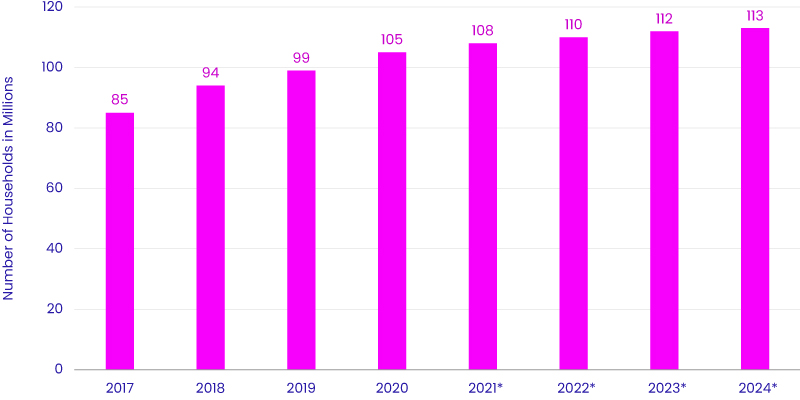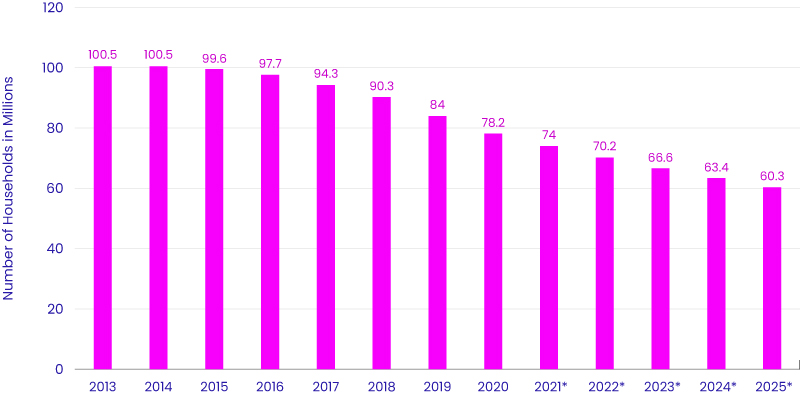The world of media planning and buying is changing rapidly, and it can seem overwhelming to keep up. We’ve written this article as a primer on CTV (Connected TV) for media planners and buyers who are just getting started with these new opportunities to create awareness and build brands.
First, you may be wondering, what the heck is CTV?
What is CTV?
From our article CTV vs OTT vs OLV, oh my!, a connected tv is a device, literally ‘a connected TV’ to the internet. A TV might use an internet connecting device such as an Xbox or Roku box to become ‘connected’ or maybe one of a newish type of TV, a ‘Smart TV’ which has internet connectivity built-in along with OTT Apps.
Connected TVs differ from ‘linear’ TVs in how they access and present video. Linear or traditional TV uses an antenna to bring in local TV stations, or a set-top box or satellite dish and box combination to provide access to cable tv programming. It’s known as linear because the content is accessed in a linear fashion, i.e., you can see what a channel will be broadcasting into the future but only access programming contemporaneously as it’s broadcast.
This jump, from linear programming via a small number of sources to video programming delivered as an internet experience, creates significant opportunities for brands to reach valuable audiences in interesting ways.
CTV advertising provides the ability to disconnect advertising targeting from the program and instead associate it with the device being targeted. This means that audiences can be defined and reached with what look like traditional TV ads in ways that have historically not been achieved through a traditional linear TV ad buy.
What does CTV Advertising mean for media buyers and planners?
We are all aware of the waning of legacy TV viewers and the growth of CTV viewership. Interestingly, it’s not an entirely either-or proposition as there is a small subset of viewers that are hanging on to their legacy TV sources even as they embrace CTV viewing. According to Statista, there has been a steady increase in CTV viewers in the US, although the growth rate appears to be leveling off a bit.

We don’t know yet if this means that we’ve moved past early adopters and are reaching a state where nearly everyone that’s going to embrace CTV is already on board, or if there will be continued migration from legacy linear TV to CTV.
What we do know is that if you want to reach the entirety of available TV audiences, you need to think in terms of both linear and connected TV.
Again, according to Statista, while the number of traditional paid TV subscribers in the US continues to decline, there are still millions of viewers to be reached via this medium.

So an important takeaway for media planners and buyers: to continue to deliver the reach that your brands are accustomed to with TV advertising, you probably need to embrace both mediums and understand where each fits strategically within each media buying plan.
That being said, there are some advantages that CTV advertising offers that traditional linear TV advertising doesn’t.
For instance, CTV advertising, being tied to a device, means that that device can be associated with a household and other devices within it. This means that advertisers can begin to connect the dots between advertising and consumption at a highly localized level, do online behaviors on other devices, and to all of the demographic data that’s associated with that address and those devices.
CTV advertising offers the best of both worlds, that is exposure in a lean-back environment where someone is a bit more likely to be paying attention and if not may be simultaneously on another device that may give signals with respect to online behavior driven by the advertising.
AudienceXpress has curated a number of attribution technology partners that can help you to make these connections in ways that linear TV doesn’t enable. An advantage to providing these associations is that we aren’t ‘grading our own homework’, in that we can provide 3rd party verification of advertising outcomes.
An interesting strategic advantage of CTV is that we are able to parse audiences by linear TV and CTV, meaning that we can ensure that as you embrace both advertising approaches that you’re not significantly overlapping audiences between the two, and in fact, we can ensure that the CTV component of your strategy is indeed augmentative to the reach that you’re getting with linear TV. Like buying display advertising programmatically, CTV advertising enables frequency capping to make sure that you get as much reach as possible for a given investment.
FreeWheel can provide access to these various audiences in unique ways. For CTV, we’re actually an ad-server. This means that we have direct access to advertising inventory that others pass through multiple layers of technology to reach. The upshot is that you avoid markups that every layer ads to the ad placing process. For linear TV, we have the ability to aggregate local audiences to create national coverage. This approach, known as ‘unwired media’, improves the cost/impression ratio while creating some unique strategic opportunities. Through our parent company Comcast, we have national cable TV reach.
What are things you should ask your CTV Advertising partner?
An important consideration is how inventory is sourced, and how close are they to that inventory?
What is the inventory, is it more premium or is it more long-tail? This may or may not be important to your strategy but you do want to know!
What will the audience targeting be?
As we noted above, CTV Advertising expands the targeting options over linear TV. Audience segments can be targeted demographic using 3rd or 1st party data, as well as Geo targeted.
A blended audience strategy, CTV and linear, can be used in creative ways, for instance you should be able to glean what your target audience has historically viewed and then target the same individual to extend reach into the right audience.
What advertising creative should be used with CTV Advertising?
It’s still TV – you can think about campaigns like you would linear TV. However, using a partner like FreeWheel Media introduces new creative ad units that can increase engagement with your brand.
How is CTV Advertising measured?
CTV Advertising campaigns can be measured and optimized relatively fluidly, with the ability to tweak and adjust campaign targeting as the campaign progresses. As we noted above, the right CTV Advertising partner can deliver solid attribution reports.
What should I ask upfront when planning CTV Advertising campaigns?
How much experience do we have with this? Should we engage a partner to bring us up the learning curve? The right partner can make this simple while increasing the confidence that you’ll get the results that you’re looking for. Another question you should ask is, can you get the scale with one strategy that your campaign goals require? The right partner can help you to know if there’s enough inventory available to a given campaign.
You should also know if the partner that you select is limited in their ability to reach the right advertising channels. In the MVPD (Multichannel Video Programming Distributor) market there’s a lot of jockeying for position. Traditional satellite TV providers are moving into linear TV and CTV, Telecom companies are in the linear TV space and expanding streaming options as well. The right partner has access to all of the right sources and can be an impartial arbiter of where you should invest to best meet your goals.
